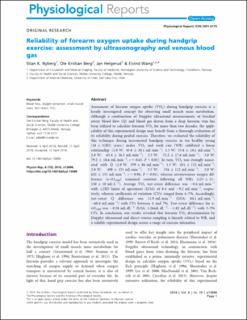| dc.contributor.author | Nyberg, Stian Kwak | |
| dc.contributor.author | Berg, Ole Kristian | |
| dc.contributor.author | Helgerud, Jan | |
| dc.contributor.author | Wang, Eivind | |
| dc.date.accessioned | 2022-10-17T08:36:50Z | |
| dc.date.available | 2022-10-17T08:36:50Z | |
| dc.date.created | 2018-05-22T11:47:16Z | |
| dc.date.issued | 2018 | |
| dc.identifier.citation | Physiological Reports. 2018, 6:e13696 (10), 1-11. | en_US |
| dc.identifier.issn | 2051-817X | |
| dc.identifier.uri | https://hdl.handle.net/11250/3026319 | |
| dc.description.abstract | Assessment of forearm oxygen uptake (O2) during handgrip exercise is a keenly investigated concept for observing small muscle mass metabolism. Although a combination of Doppler ultrasound measurements of brachial artery blood flow () and blood gas drawn from a deep forearm vein has been utilized to calculate forearm O2 for more than two decades, the applicability of this experimental design may benefit from a thorough evaluation of its reliability during graded exercise. Therefore, we evaluated the reliability of this technique during incremental handgrip exercise in ten healthy young (24 ± 3(SD) years.) males. O2 and work rate (WR) exhibited a linear relationship (1.0 W: 43.8 ± 10.1 mL·min−1; 1.5 W: 53.8 ± 14.1 mL·min−1; 2.0 W: 63.4 ± 16.3 mL·min−1; 2.5 W: 72.2 ± 17.6 mL·min−1; 3.0 W: 79.2 ± 18.6 mL·min−1; r = 0.65, P < 0.01). In turn, O2 was strongly associated with (1.0 W: 359 ± 86 mL·min−1; 1.5 W: 431 ± 112 mL·min−1; 2.0 W: 490 ± 123 mL·min−1; 2.5 W: 556 ± 112 mL·min−1; 3.0 W: 622 ± 131 mL·min−1; r = 0.96; P < 0.01), whereas arteriovenous oxygen difference (a‐vO2diff) remained constant following all WRs (123 ± 11–130 ± 10 mL·L−1). Average O2 test–retest difference was −0.4 mL·min−1 with ±2SD limits of agreement (LOA) of 8.4 and −9.2 mL·min−1, respectively, whereas coefficients of variation (CVs) ranged from 4–7%. Accordingly, test–retest difference was 11.9 mL·min−1 (LOA: 84.1 mL·min−1; −60.4 mL·min−1) with CVs between 4 and 7%. Test–retest difference for a‐vO2diff was −0.28 mL·dL−1 (LOA: 1.26mL·dL−1; −1.82 mL·dL−1) with 3–5% CVs. In conclusion, our results revealed that forearm O2 determination by Doppler ultrasound and direct venous sampling is linearly related to WR, and a reliable experimental design across a range of exercise intensities. | en_US |
| dc.language.iso | eng | en_US |
| dc.relation.uri | https://physoc.onlinelibrary.wiley.com/doi/10.14814/phy2.13696 | |
| dc.rights | Navngivelse 4.0 Internasjonal | |
| dc.rights.uri | http://creativecommons.org/licenses/by/4.0/deed.no | |
| dc.title | Reliability of forearm oxygen uptake during handgrip exercise : assessment by ultrasonography and venous blood gas | en_US |
| dc.type | Peer reviewed | en_US |
| dc.type | Journal article | en_US |
| dc.description.version | publishedVersion | en_US |
| dc.source.pagenumber | 1-11 | en_US |
| dc.source.volume | 6 | en_US |
| dc.source.journal | Physiological Reports | en_US |
| dc.source.issue | 10 | en_US |
| dc.identifier.doi | 10.14814/phy2.13696 | |
| dc.identifier.cristin | 1585891 | |
| dc.source.articlenumber | e13696 | en_US |
| cristin.unitcode | 211,2,0,0 | |
| cristin.unitname | Avdeling for helse- og sosialfag | |
| cristin.ispublished | true | |
| cristin.fulltext | original | |
| cristin.qualitycode | 1 | |

